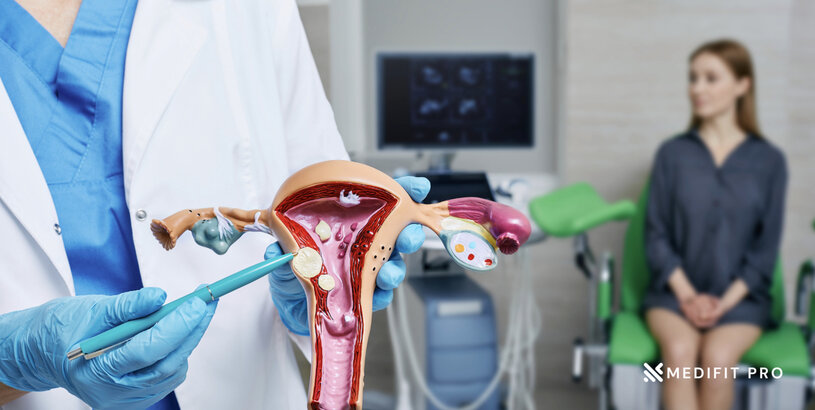Fibroids are non-cancerous growths that develop in the uterus and are extremely common among women of reproductive age. In fact, it’s estimated that approximately 80% of women will develop fibroids at some point in their lives. These growths can vary in size, from tiny seedlings to large masses that can fill the entire uterus. Although fibroids are not cancerous, they can cause a variety of symptoms and complications that can impact a woman’s quality of life.
What are fibroids?
Fibroids are made up of muscle and connective tissue and can form in different parts of the uterus, including the wall, cervix, and inside the uterine cavity. They can range in size from tiny seedlings to large masses that can fill the entire uterus. They can be single or multiple and can grow slowly or rapidly. The exact cause of fibroids is not known, but hormonal imbalances, genetics, and lifestyle factors are believed to play a role.
Prevalence of fibroids
Fibroids are extremely common among women of reproductive age and are estimated to affect approximately 80% of women at some point in their lives. The prevalence of fibroids increases with age and is more common in African American women. While fibroids are not cancerous, they can cause a variety of symptoms and complications that can impact a woman’s quality of life.
Navigating fibroids is important for several reasons:
- Maintaining reproductive health: Fibroids can cause heavy or prolonged periods, pain during sex, and in severe cases, infertility or miscarriage. Navigating fibroids can help to address these symptoms and maintain reproductive health.
- Improving quality of life: The symptoms of fibroids can impact a woman’s quality of life, including her ability to work and participate in daily activities. Navigating fibroids can help to manage symptoms and improve overall quality of life.
- Preventing complications: In severe cases, fibroids can cause premature labor, which can be dangerous for both the mother and the baby. Navigating fibroids can help to prevent these complications and ensure a healthy pregnancy.
- Making informed decisions: There are several treatment options for fibroids, including medication, surgery, and minimally invasive procedures. Navigating fibroids can help women make informed decisions about their treatment options and choose the best option for their individual needs.
- Promoting overall health: Fibroids can be a sign of hormonal imbalances, which can impact overall health. Navigating fibroids can help to address these imbalances and promote overall health.
Causes of Fibroids
The exact cause of fibroids is not known, but several factors are believed to play a role in their development, including:
- Hormonal imbalances: Estrogen and progesterone, the two hormones that regulate the menstrual cycle, are believed to play a role in the growth of fibroids. Higher levels of these hormones can stimulate the growth of fibroids.
- Genetics: Fibroids can run in families, suggesting a genetic component to their development.
- Lifestyle factors: Obesity, a high-fat diet, and sedentary lifestyle have been linked to an increased risk of developing fibroids.
- Age: The incidence of fibroids increases with age, and women over the age of 50 are more likely to develop fibroids.
- Ethnicity: African American women are more likely to develop fibroids than women of other ethnicities.
It’s important to note that not all women with these risk factors will develop fibroids, and many women with fibroids have no known risk factors. Additionally, fibroids can develop in women of any age and can range in size from tiny seedlings to large masses that fill the entire uterus.
Symptoms of Fibroids
The symptoms of fibroids can vary depending on the size, location, and number of growths, but common symptoms include:
- Heavy or prolonged periods: Fibroids can cause heavy or prolonged menstrual bleeding, which can be accompanied by cramping and discomfort.
- Pain during sex: Fibroids can cause pain or discomfort during sexual intercourse.
- Lower back pain: Fibroids can cause pressure on the lower back and result in chronic pain.
- Frequent urination: Large fibroids can put pressure on the bladder and cause frequent urination.
- Constipation: Fibroids can also put pressure on the rectum and cause constipation.
- Infertility: In severe cases, fibroids can cause infertility or increase the risk of miscarriage.
- Pressure or fullness in the lower abdomen: Large fibroids can cause a feeling of pressure or fullness in the lower abdomen.
It’s important to note that not all women with fibroids will experience symptoms, and some women may only experience mild symptoms.
Types of Fibroids
There are several different types of fibroids, including:
- Submucosal fibroids: These fibroids grow just under the inner lining of the uterus and can cause heavy or prolonged menstrual bleeding.
- Intramural fibroids: These fibroids grow within the wall of the uterus and can cause pressure or discomfort in the lower abdomen.
- Subserosal fibroids: These fibroids grow on the outer surface of the uterus and can cause pain in the lower back and legs.
- Pedunculated fibroids: These fibroids are attached to the uterus by a stalk and can cause discomfort or pressure in the lower abdomen.
- Cervical fibroids: These fibroids grow in the cervix and can cause heavy or prolonged menstrual bleeding.
It’s important to note that a single uterus can contain more than one type of fibroid, and the size, location, and number of fibroids can impact the symptoms a woman experiences. Additionally, fibroids can grow in different ways and can change in size and location over time, which can impact the symptoms a woman experiences.
Diagnosis
Fibroids are often diagnosed during a routine pelvic exam, but several other diagnostic tests can be used to confirm the presence of fibroids and determine their size, location, and number.
These tests may include:
- Ultrasound: A transvaginal or abdominal ultrasound can be used to visualize the uterus and surrounding structures, allowing for the accurate detection and characterization of fibroids.
- Magnetic Resonance Imaging (MRI): An MRI can be used to produce detailed images of the uterus and surrounding structures, providing information about the size, location, and number of fibroids.
- Hysterosalpingogram (HSG): An HSG is an X-ray test that uses a special dye to visualize the uterus and fallopian tubes, providing information about the size, shape, and location of fibroids.
- Hysteroscopy: A hysteroscopy is a procedure that allows for the direct visualization of the inside of the uterus using a thin, lighted instrument called a hysteroscope. This procedure can be used to diagnose and remove fibroids.
If fibroids are suspected, your healthcare provider will perform a thorough evaluation, including a detailed medical history and physical exam, to determine the best diagnostic approach and guide your individualized treatment plan.
Treatment Options
Medical Treatment for Fibroids
Medical treatment for fibroids typically involves the use of medications to manage symptoms and shrink the size of the growths. Some common medical treatments for fibroids include:
- Non-steroidal anti-inflammatory drugs (NSAIDs): NSAIDs, such as ibuprofen, can be used to manage pain and reduce menstrual bleeding associated with fibroids.
- Hormonal birth control: Hormonal birth control, such as the pill, patch, or ring, can be used to regulate menstrual cycles and reduce heavy bleeding associated with fibroids.
- Gonadotropin-releasing hormone (GnRH) agonists: GnRH agonists, such as leuprolide, can be used to shrink the size of fibroids by temporarily stopping the production of estrogen and progesterone, two hormones that stimulate the growth of fibroids.
- Progestin-releasing intrauterine devices (IUDs): Progestin-releasing IUDs, such as Mirena, can be used to regulate menstrual cycles and reduce heavy bleeding associated with fibroids.
Minimally Invasive Procedures for Treating Fibroids
Minimally invasive procedures are a type of treatment for fibroids that use specialized techniques to remove or destroy the growths without the need for a traditional surgical incision. Some common minimally invasive procedures for treating fibroids include:
- Uterine artery embolization (UAE): UAE is a procedure that blocks the blood supply to the fibroids, causing them to shrink over time. During the procedure, a small incision is made in the groin area and a catheter is inserted into the uterus to deliver tiny particles that block the blood flow to the fibroids.
- Radiofrequency ablation (RFA): RFA is a procedure that uses heat to destroy the fibroids. During the procedure, a small incision is made in the lower abdomen and a radiofrequency probe is inserted into the uterus to deliver heat to the fibroids.
- Laparoscopic myomectomy: Laparoscopic myomectomy is a minimally invasive surgical procedure to remove the fibroids while preserving the uterus. During the procedure, several small incisions are made in the abdomen and a laparoscope is used to view and remove the fibroids.
- Hysteroscopic myomectomy: Hysteroscopic myomectomy is a minimally invasive surgical procedure to remove fibroids that are located within the uterus. During the procedure, a hysteroscope is inserted into the uterus through the cervix to view and remove the fibroids.
Minimally invasive procedures offer several benefits over traditional surgical procedures, including faster recovery times, less pain and scarring, and a lower risk of complications. It’s important to work with your healthcare provider to determine the best minimally invasive procedure for your individual needs and circumstances.
Surgical Options
Surgical treatment options for fibroids are typically recommended for women who have larger fibroids, heavy menstrual bleeding, or persistent symptoms that do not respond to other treatments. Some common surgical treatments for fibroids include:
- Hysterectomy: Hysterectomy is a surgical procedure to remove the uterus and is typically recommended for women who no longer wish to become pregnant. This procedure is considered a permanent solution for fibroids, as the uterus is removed along with the fibroids.
- Myomectomy: Myomectomy is a surgical procedure to remove the fibroids while preserving the uterus. This procedure is typically recommended for women who wish to preserve their ability to become pregnant. Myomectomy can be performed through a traditional incision, or through minimally invasive techniques such as laparoscopic or hysteroscopic myomectomy.
- Endometrial ablation: Endometrial ablation is a procedure to remove the inner lining of the uterus, which can reduce heavy menstrual bleeding associated with fibroids. This procedure is not recommended for women who wish to become pregnant.
- Laparoscopic-assisted vaginal hysterectomy (LAVH): LAVH is a minimally invasive surgical procedure that involves removing the uterus through the vagina using small incisions in the abdomen.
It’s advised to work with your healthcare provider to determine the best surgical treatment for your individual needs and circumstances. Factors that may impact the decision to undergo surgery include the size and location of the fibroids, the woman’s age and desire for future pregnancy, and her overall health and medical history.
Lifestyle Changes
Healthy lifestyle changes can play an important role in managing fibroids and reducing their symptoms. Some recommendations for healthy lifestyle changes to consider include:
- Maintaining a healthy weight: Being overweight or obese can increase the risk of developing fibroids and can make existing fibroids grow larger. Losing weight and maintaining a healthy weight can help to reduce the risk of fibroids and the associated symptoms.
- Exercise regularly: Regular exercise can help to maintain a healthy weight, reduce stress, and improve overall health. Aim for at least 30 minutes of moderate-intensity exercise on most days of the week.
- Eat a balanced diet: A diet that is high in fresh fruits and vegetables, whole grains, and lean protein can help to maintain a healthy weight and reduce the risk of fibroids. Avoid foods that are high in fat and sugar.
- Limit alcohol and caffeine consumption: Drinking large amounts of alcohol and caffeine can increase the risk of fibroids and make existing fibroids grow larger. Limiting or avoiding alcohol and caffeine can help to reduce the risk of fibroids and the associated symptoms.
- Reduce stress: Chronic stress can have a negative impact on overall health, including the development of fibroids. Find ways to manage stress, such as through exercise, meditation, or talking to a therapist.
In some cases, lifestyle changes may not be enough to manage fibroids, and additional treatments, such as medications or minimally invasive procedures, may be necessary.
Support for Navigating Fibroids

Navigating fibroids can be a difficult and overwhelming experience, but there are many resources available to provide support and help you manage your condition. Here are some options to consider:
- Healthcare providers: Your healthcare provider is your best resource for understanding fibroids, diagnosing your condition, and determining the best treatment options for you. Your provider can also provide you with guidance and support as you navigate your fibroids.
- Support groups: Joining a support group can provide you with a sense of community and a place to connect with other women who are experiencing similar symptoms and challenges. You can find support groups online, in your community, or through local hospitals or clinics.
- Online resources: There are many websites and online communities dedicated to providing information and support for women with fibroids. You can find forums, discussion groups, and educational resources that can help you better understand your condition and find support.
- Friends and family: Your friends and family can be a valuable source of support as you navigate your fibroids. They can offer emotional support, help you manage your symptoms, and provide practical assistance as needed.
- Therapists or counselors: If you’re feeling overwhelmed or struggling to cope with your fibroids, you may find it helpful to talk to a therapist or counselor. A mental health professional can provide you with strategies to manage stress, anxiety, and depression and help you find ways to cope with your condition.
Remember, it’s important to take care of your physical and emotional health as you navigate your fibroids. Don’t be afraid to ask for help or to reach out for support when you need it. With the right resources and support, you can manage your fibroids and maintain your overall health and well-being.

























Recent Comments